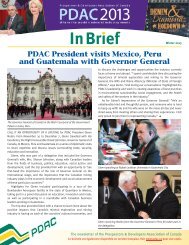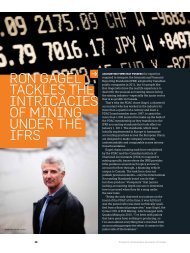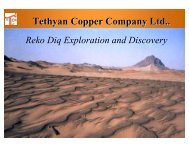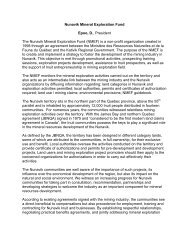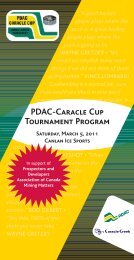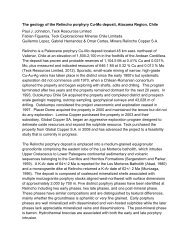Lands & Regulation - Nunavut Planning - Industry Letter
Lands & Regulation - Nunavut Planning - Industry Letter
Lands & Regulation - Nunavut Planning - Industry Letter
Create successful ePaper yourself
Turn your PDF publications into a flip-book with our unique Google optimized e-Paper software.
November 15, 2010<br />
BY E-MAIL AND BY FAX TO: 819-953-4941<br />
The Hon. John Duncan<br />
Minister of Indian Affairs and Northern Development, Federal Interlocutor<br />
for Métis and Non-Status Indians, and Minister Responsible for the<br />
Canadian Northern Economic Development Agency<br />
Ottawa, Ontario<br />
K1A 0A6<br />
Dear Minister Duncan:<br />
Re:<br />
Bill C-25: the Proposed <strong>Nunavut</strong> <strong>Planning</strong> and Project Assessment Act<br />
This letter is submitted on behalf of the Northwest Territories and <strong>Nunavut</strong> Chamber of Mines<br />
(NWTNCM), the Mining Association of Canada (MAC) and the Prospectors and Developers Association<br />
of Canada (PDAC) in relation to Bill C-25, the proposed <strong>Nunavut</strong> <strong>Planning</strong> and Project Assessment Act<br />
that was tabled in the House of Commons for First Reading on May 12, 2010. In preparation for further<br />
debate and review of C-25, we are writing to urge the federal government to propose a number of<br />
amendments to address the principal issues and concerns that our members have identified with regard to<br />
the proposed legislation.<br />
Mineral Sector Consultation in Anticipation of Bill C-25<br />
The mineral sector encourages governments to establish regulatory regimes that promote sustainable<br />
development, while at the same time enabling the private sector to undertake responsible mineral resource<br />
initiatives that have the potential to generate economic and social benefits that will improve the lives of<br />
local residents, particularly Aboriginal peoples, and those of other Canadians. To give effect to these<br />
principles in this instance, the NWTNCM, PDAC and MAC have actively participated in the extensive<br />
consultation process that Indian and Northern Affairs Canada has conducted in order to solicit the views<br />
of the mineral sector in relation to the proposed enactment.<br />
The department initiated this dialogue in April 2009 when it first developed draft legislation in the form<br />
of the <strong>Nunavut</strong> Land Use <strong>Planning</strong> and Impact Assessment Act. The discussions that followed included<br />
four workshops that INAC officials convened with industry representatives. The most recent of these was<br />
the session that took place in Vancouver on June 4 of this year after the bill had been tabled in the House.<br />
During the preceding months, the NWTNCM, PDAC and MAC submitted three detailed reviews of the<br />
successive versions of the draft legislation that the department had made available, on a confidential<br />
basis, for our joint review.<br />
Throughout this process, we have expressed our appreciation for the opportunity to contribute to the<br />
development of this critically important legislation. Moreover, we commend the federal government for<br />
fulfilling this long-standing obligation under the 1993 <strong>Nunavut</strong> Land Claims agreement. We understand<br />
Page 1 of 9
that, once proclaimed into force, Bill C-25 will complete the statutory regime for land use planning and<br />
environmental and socio-economic impact assessment that the land claims agreement requires.<br />
With these overarching objectives in mind, our associations support the passage of the legislation. We<br />
maintain that, when appropriately implemented, a balanced and efficient land use and impact assessment<br />
regime will enhance the capacity of <strong>Nunavut</strong> to compete for the high-risk exploration and development<br />
investments that are critical in order to ensure that Nunavummiut and other Canadians derive full benefit<br />
from the territory’s considerable mineral endowment.<br />
Issues of Continuing Concern<br />
Against this backdrop, it is gratifying to note the enhancements and refinements that the legislative<br />
drafting team has progressively implemented as the draft bill has evolved. However, certain provisions<br />
continue to trouble the mineral exploration sector, particularly those that appear to be inconsistent with<br />
the federal government’s on-going commitment to ensuring that regulatory processes in the north are<br />
clear, efficient, timely and balanced.<br />
A number of the provisions that continue to raise concerns are discussed in the appendix to this letter,<br />
which also outlines suggested amendments. We submit that four key elements of the proposed legislation<br />
should be given particular consideration and, where indicated, should be amended, for the reasons<br />
outlined below:<br />
(a)<br />
Definition of “Project”<br />
The definition of the term “project” in subsection 2(1) of Bill C-25 is extremely broad. As<br />
presently written, it could be interpreted to encompass low-level, innocuous activities that are<br />
unlikely to have any adverse environmental or socio-economic impacts. Nonetheless, if these<br />
kinds of activities could still qualify as a “project” under the proposed definition, they must be<br />
submitted to the <strong>Nunavut</strong> <strong>Planning</strong> Commission for review. Given that the draft bill provides<br />
significant penalties for failure to do so, proponents may feel compelled to over-report. If that<br />
becomes the case, they will incur unnecessary effort and expense, while diverting the resources of<br />
the commission from more important work.<br />
We note that paragraph 228(2)(a) of the draft bill authorizes the making of regulations in order to<br />
define “...excluded works or activities” for the purposes of the definition of “project”. In our<br />
view, regulations of this kind could potentially mitigate some of the risks posed by the current<br />
definition.<br />
We therefore recommend that the legislation not be proclaimed into force until the regulations<br />
envisaged by paragraph 228(2)(a) are ready for promulgation. For similar reasons, we<br />
recommend that Schedule 3, entitled “Classes of Works and Activities Exempt from Screening”,<br />
be likewise completed before Bill C-25 is proclaimed into force. Consistent with our approach to<br />
the draft legislation to date, our associations would be pleased to contribute to the development<br />
and review of the draft regulations and the proposed schedule.<br />
(b)<br />
Creation of Offences Under Land Use Plans<br />
When taken together, subsection 48(4), paragraph 74(f) and subsection 219(1) of the draft bill<br />
provide that a land use plan can incorporate specific requirements that, if contravened, would<br />
constitute an offence. The maximum penalties that may be imposed for non-compliance are<br />
considerable, namely a fine of not more than $100,000, imprisonment for a period of up to one<br />
year, or both.<br />
Page 2 of 9
We are not aware of any other jurisdiction where statutory provisions authorize land use plans to<br />
establish quasi-criminal offences. Moreover, the relevant provisions of the <strong>Nunavut</strong> Land Claims<br />
Agreement, including those contained in Article 11, do not contemplate measures of this kind.<br />
In our view, other laws of general application that prevail in <strong>Nunavut</strong> already provide sufficient<br />
deterrents, by way of significant fines and other penalties, to deter environmental misconduct or<br />
non-compliance. We respectfully submit that the need for Bill C-25 to add an unorthodox<br />
enforcement mechanism to the existing regulatory regimes has not been justified. We therefore<br />
recommend that subsection 48(4) of Bill C-25 be deleted, along with the corresponding reference<br />
to that provision in section 74.<br />
(c)<br />
Proposed Requirements for Minor Variances<br />
As envisaged by section 11.5.10 of the <strong>Nunavut</strong> Land Claims Agreement, Bill C-25 provides for<br />
the granting of minor variances, where appropriate, from the requirements of land use plans.<br />
However, section 81 of the proposed enactment would establish an exhaustive regime governing<br />
such variances. The resulting process would include a public announcement, the right of any<br />
person to file a submission opposing the variance, an obligation on the <strong>Nunavut</strong> <strong>Planning</strong><br />
Commission to consider such submissions, and, where warranted, a public review of the minor<br />
variance application.<br />
Moreover, once invoked, this process would exempt the commission from complying with the 45-<br />
day time limit for determining whether the development proposal conforms to the applicable land<br />
use plan.<br />
The complex consultation process contemplated by the draft legislation for minor variances,<br />
particularly the potential requirement for a public review, seems burdensome and excessive. This<br />
is particularly the case when one considers that the proposed regime is meant to apply exclusively<br />
to minor variances. An elaborate scheme of this nature may well be unnecessary if, as<br />
contemplated by subsection 48(3) of the draft bill, the applicable land use plan clearly spells out<br />
the conditions that must be satisfied before a minor variance can be granted.<br />
We therefore suggest that the Commission, in and of its own accord, should discharge the<br />
responsibility of determining whether or not a minor variance will be granted or denied. An<br />
appropriate level of public awareness of such variances could still be ensured by filing written<br />
reasons prepared pursuant to paragraph 150(b) in the commission’s public registry.<br />
Consequently, we recommend that section 81 of Bill C-25 should be amended by deleting<br />
subsections (3), (4) and (5).<br />
(d)<br />
Timelines and Timeframes<br />
We acknowledge that, by incorporating a significant number of timelines and timeframes as part<br />
of the overall environmental and socio-economic impact assessment process, Bill C-25 is<br />
intended to establish an assessment and review regime that has the potential to be more rigorous<br />
and timely than the process envisaged by earlier versions of the draft legislation.<br />
However, a number of the proposed timeframes and timelines continue to be of concern to the<br />
mineral exploration sector.<br />
First, there are those that could potentially extend for as much as 180 days or six months, and<br />
therefore seem unnecessarily long. Examples include the following:<br />
Page 3 of 9
section 95 (modification or abandonment of a project) – 120 days plus a potential<br />
extension for an additional 60 days;<br />
section 105 (ministerial decision following a determination by the <strong>Nunavut</strong> Impact<br />
Review Board (NIRB) that a project should proceed) – 120 days plus a potential<br />
extension for an additional 60 days; and<br />
section 106 (ministerial decision following a determination by the NIRB that a project<br />
should not proceed) – 120 days plus a potential extension for an additional 60 days).<br />
Second, of even greater concern are the elements of the process that could last for as much as 360<br />
days, or essentially an entire year, instances of which are as follows:<br />
section 125 (ministerial decision following a determination by a federal environmental<br />
assessment panel that project should proceed) – 180 days plus a potential extension for an<br />
additional 180 days;<br />
section 126 (ministerial decision following a determination by a federal environmental<br />
assessment panel that project should not proceed) – 180 days plus a potential extension<br />
for an additional 180 days;<br />
Conversely, there are elements of the assessment and review process that, in our view, should<br />
have been the subject of timelines or timeframes, but none have been provided for. Examples<br />
include:<br />
section 99 – determination of the scope of a project by the NIRB;<br />
section 101 – development, approval and issuance of the guidelines for the preparation of<br />
an environmental and socio-economic impact statement; and<br />
sections 102 and 103 – conduct and completion of the review of the proposed project by<br />
the NIRB.<br />
We further note that subsection 92(4) authorizes the Minister to extend the 45-day period for<br />
submission of the report that the NIRB is required to submit pursuant to subsection 92(1).<br />
However, unlike other provisions that authorize an extension, subsection 92(4) does not<br />
specifically limit the number of days for which the extension can be made.<br />
Finally, we note that the words “as soon as practicable” are used in section 110, subsection<br />
112(9), subsection 120(8) and section 131. However, the draft legislation provides no further<br />
guidance as to how quickly the actions described in those sections must be completed.<br />
In our analysis, under a “worst case scenario” the timelines and timeframes that currently appear<br />
in the proposed legislation could potentially require up to 800 days in order to complete the<br />
overall impact assessment process. However, as noted above, no timelines or timeframes have<br />
been provided for a number of important steps in the overall process. Taking all of these factors<br />
into account, and having regard to past environmental assessments, experienced industry<br />
observers have suggested that, under Bill C-25, three to five years could potentially be needed to<br />
complete the assessment of a major mining project in <strong>Nunavut</strong>. While a time period of this<br />
Page 4 of 9
magnitude will hopefully never be required, we submit that it demonstrates the need for further<br />
adjustment of the timelines and timeframes that the draft enactment currently contemplates.<br />
The mineral exploration and mining sector fully respects the need for the key institutions of<br />
public government, notably the <strong>Nunavut</strong> <strong>Planning</strong> Commission and the <strong>Nunavut</strong> Impact Review<br />
Board, to have sufficient time to discharge their highly important responsibilities. At the same<br />
time, however, the competitive position of <strong>Nunavut</strong> will be impaired, particularly from a mineral<br />
exploration perspective, if prospective investors perceive that the regulatory process that Bill C-<br />
25 ultimately implements is inefficient, onerous or unduly prolonged. We therefore recommend<br />
that the applicable provisions of the draft legislation should be carefully reconsidered in order to<br />
adjust the existing timelines and timeframes and incorporate new ones where required.<br />
In conclusion, we respectfully submit that the statutory environmental and socio-economic impact<br />
assessment process in <strong>Nunavut</strong> must be designed to respond to proposals for mineral exploration, mine<br />
development and mining operations in an efficient, transparent and timely manner. At the same time,<br />
however, the process must honour the principles, goals and objectives set out in the <strong>Nunavut</strong> Land Claims<br />
Agreement, while giving full effect to the federal government’s commitment to optimize regulatory<br />
regimes in Canada’s north.<br />
We appreciate the opportunity to bring these views to your attention, and would be pleased to provide any<br />
additional information. Representatives of our three associations remain available to meet with your<br />
departmental officials to discuss the issues outlined above or those summarized in the attached document.<br />
Yours sincerely,<br />
John Kearney Gordon Peeling Tony Andrews<br />
President President and CEO Executive Director<br />
NWTNCM MAC PDAC<br />
c.c.<br />
The Hon. Leona Aglukkak, Minister of Health and Regional Minister for<br />
Northwest Territories, <strong>Nunavut</strong> and Yukon<br />
The Hon. Dennis G. Patterson, Senator for <strong>Nunavut</strong><br />
Shelly Glover, MP, Parliamentary Secretary to the Minister of Indian Affairs and Northern<br />
Development<br />
The Hon. Peter Taptuna, Minister of Economic Development and Transportation,<br />
Government of <strong>Nunavut</strong><br />
Patrick O’Neill, Director, Mineral Resources Directorate, Indian and Northern Affairs Canada<br />
Stephen Traynor, Director, Resource Policy and Programs Directorate,<br />
Indian and Northern Affairs Canada<br />
Jose Kusugak, Acting-President, <strong>Nunavut</strong> Tunngavik Incorporated<br />
Page 5 of 9
APPENDIX TO THE NWTNCM, MAC and PDAC LETTER<br />
TO THE HON. JOHN DUNCAN,<br />
MINISTER OF INDIAN AFFAIRS AND NORTHERN DEVELOPMENT,<br />
DATED NOVEMBER 15, 2010<br />
Additional Issues of Concern and Suggested Amendments in Relation to<br />
Bill C-25, the Proposed <strong>Nunavut</strong> <strong>Planning</strong> and Project Assessment Act<br />
1. Subsection 38(2) – NPC and NIRB By-laws and Rules<br />
Bill C-25 defines an “interested corporation or organization” as “...a corporation or<br />
other organization that has given written notice to the Commission, the Board or any<br />
federal environmental assessment panel, as the case may be, of its interest in providing<br />
comments.”<br />
The defined term subsequently appears in two sections of the proposed enactment:<br />
(a)<br />
(b)<br />
in section 43, where the <strong>Nunavut</strong> <strong>Planning</strong> Commission is required to “...seek the<br />
opinions of affected municipalities, interested corporations and organizations,<br />
residents and other interested persons regarding specific objectives and land use<br />
planning options for the region”; and<br />
in subsection 50(2), which requires the Commission to “...solicit written and oral<br />
comments on the draft land use plan from appropriate departments or agencies,<br />
designated Inuit organizations, affected municipalities, interested corporations<br />
and organizations, Inuit and other residents of the designated area and the<br />
general public”.<br />
However, the defined term is not used in the same way in subsection 38(2), which<br />
pertains to the development of by-laws and rules by the <strong>Nunavut</strong> <strong>Planning</strong> Commission<br />
and the <strong>Nunavut</strong> Impact Review Board.<br />
It is therefore recommended that subsection 38(2) utilize the defined term “interested<br />
corporation or organization” and be amended to read as follows:<br />
(2) The notice referred to in paragraph (1)(b) must include an invitation to<br />
interested persons, including interested corporations and organizations, to<br />
make comments in writing to the Commission or the Board about the proposed<br />
by-law or rule within 60 days after publication of the notice.<br />
Page 6 of 9
2. Section 104 – Conditions Recommended by NIRB Following Project Review<br />
Subsection 104(1) establishes that the <strong>Nunavut</strong> Impact Review Board must submit a<br />
written report to the responsible Minister within 45 days after completing its review of a<br />
project. If the board determines that a project should proceed, it must include any terms<br />
and conditions that it recommends should apply in respect of the project.<br />
The previous version of the proposed enactment qualified the scope of such terms and<br />
conditions. It specified that they must be consistent with “...the objectives set out in<br />
section 23” of the proposed legislation. Section 23 is similar to the corresponding<br />
provisions of the <strong>Nunavut</strong> Land Claims Agreement which establishes the following as<br />
NIRB’s primary objectives:<br />
(a)<br />
(b)<br />
to protect and promote the existing and future well-being of the residents and<br />
communities of the designated area; and<br />
to protect the ecosystemic integrity of the designated area.<br />
If the legislation does not incorporate guidance of this kind, the discretion of NIRB could<br />
be interpreted to be very broad. This could potentially induce the board to recommend<br />
terms and conditions that are not strictly in keeping with its statutory mandate or in full<br />
accordance with the <strong>Nunavut</strong> Land Claims Agreement.<br />
Consequently, it is recommended that paragraph (c) of section 104(1) should be amended<br />
to restore the cross-reference to section 23 of the proposed enactment, and therefore read<br />
as follows:<br />
(c)<br />
if it determines that a project should proceed, any terms and conditions that,<br />
consistent with the objectives set out in section 23, the Board<br />
recommends should apply in respect of the project.<br />
3. Section 154 – Exempting Exploration or Development Activities from Review<br />
Subsection 154(1) of Bill C-25 authorizes exploration and development activities “...that<br />
relate directly to a project” that is already under review to proceed without a separate<br />
review, provided that they fall within certain specified exemptions. The legislation<br />
further provides that these activities should be allowed to go ahead where “...in the<br />
Board`s opinion, [they may] proceed without such a review”. However, the draft<br />
legislation gives no specific indication as to when NIRB should exercise this discretion,<br />
or how the board would go about doing so.<br />
In contrast, subsection 86(2) of Bill C-25 recognizes the benefit to be gained by having<br />
NIRB consult with the proponent whenever the board contemplates making an inclusion<br />
in, or an exclusion from, the scope of a proposed project when performing the “scoping”<br />
function.<br />
Page 7 of 9
It is therefore recommended that subsection 154(1) and, in particular paragraph (b) of that<br />
subsection, adopt an analogous approach, and be amended to read as follows:<br />
154. (1) ...the proponent may undertake or carry out exploration or<br />
development activities that relate directly to a project that is subject to a<br />
review under this Part if<br />
. . .<br />
(b) the activities may, in the Board’s opinion, after consulting with<br />
the proponent, proceed without such a review.<br />
The proposed amendment may be of particular importance until Schedule 3 of Bill C-<br />
215 has been enacted to define works and undertakings that are exempt from screening,<br />
and until regulations made pursuant to paragraph 228(2)(b) have defined any “class of<br />
non-exempt activities” as contemplated by paragraph 154(1)(a) that are subject to the<br />
proposed enactment.<br />
4. Section 208 – Exemption of a Suspended Project from Assessment<br />
Section 208 provides that certain projects are exempt from an assessment under Part 3<br />
of the proposed enactment. Paragraph 208(1)(b) states that exempt projects include<br />
“...the rebuilding of a work that has been closed for a period of less than five years if it<br />
relates to a project that was approved under [Part 3] and lawfully carried out”.<br />
By incorporating the words “...and lawfully carried out...”, section 208 would<br />
potentially have the effect of disqualifying a project from the exemption that would<br />
otherwise be available because of an infraction of some other law or regulation, no<br />
matter how minor or unrelated to adverse environmental or socio-economic impacts the<br />
non-compliance may have been.<br />
Paragraph 208(1)(b) should therefore be amended to ensure that the exemption from<br />
further review will only be denied where the project has not been carried out<br />
substantially in accordance with the proposed legislation.<br />
It is therefore recommended that paragraph 208(1)(b) be revised to read as follows:<br />
(b)<br />
the rebuilding of a work that has been closed for less than five years if it<br />
relates to a project that was approved under [Part 3] and has been carried<br />
out substantially in accordance with this Act.<br />
5. Section 235 – Exemption of a Project Being Assessed under the NLCA<br />
Paragraph 235(1)(a) exempts, from the application of Bill C-25, “...any project that is<br />
being assessed under the [<strong>Nunavut</strong> Land Claims] Agreement or is being, or has been,<br />
lawfully carried out on the day this section comes into force.”<br />
Page 8 of 9
For reasons analogous to those outlined above in relation to section 208, a project would<br />
be denied the benefit of this exemption on account of any infraction of a law or<br />
regulation, no matter how minor or unrelated to adverse environmental or socioeconomic<br />
impacts.<br />
It is therefore recommended that paragraph 235(1)(a) be revised to read as follows:<br />
(a)<br />
a project that is being assessed under the Agreement or is being, or has<br />
been, carried out in accordance with any project certificate or<br />
amended project certificate issued pursuant to the Agreement on the<br />
day on which this section comes into force.”<br />
6. Sections 210 and 214 – Authority to Enter and Make Orders<br />
Section 210 of Bill C-25 grants very broad powers to a person “...who is designated to<br />
verify compliance with [the legislation] or orders made under section 214...” to enter<br />
any place where a project is being carried out. The powers granted to that person<br />
include the authority to direct “...any person to put any machinery, vehicle or equipment<br />
in the place into operation or to cease operating it.”<br />
The proposed enactment does not impose any limits or conditions on the designated<br />
person when he or she exercises this power, or the related power to “...prohibit or limit<br />
access to all or part of the place” where a project is being carried out.<br />
Section 214 authorizes a “designated person” to issue orders to a person or entity to<br />
cease doing something that is in violation of the draft legislation, or to take any measure<br />
that the designated person considers necessary to comply with the legislation or mitigate<br />
the effects of a contravention. Any such order must be in writing, and must include the<br />
reasons for the order, as well as the time and manner in which it is to be carried out.<br />
The powers contemplated by these two sections are far-reaching, and appear to be much<br />
more extensive, for example, than those accorded to an inspector appointed under the<br />
<strong>Nunavut</strong> Waters and <strong>Nunavut</strong> Surface Rights Tribunal Act. Moreover, the relationship<br />
between the powers listed under section 210 and those specified in section 214 is not<br />
entirely clear.<br />
It is therefore recommended that the entry, inspection and enforcement powers to that<br />
the “designated person” is allowed to exercise be consolidated in a single<br />
comprehensive section of the proposed enactment. More importantly, it is also<br />
recommended that this provision be amended to specify that these powers can only be<br />
exercised: (i) in circumstances where they are reasonably required in order to ensure<br />
compliance with the legislation or prevent a contravention; and (ii) in a manner that will<br />
not compromise the health or safety of any person or cause damage to the environment.<br />
Page 9 of 9


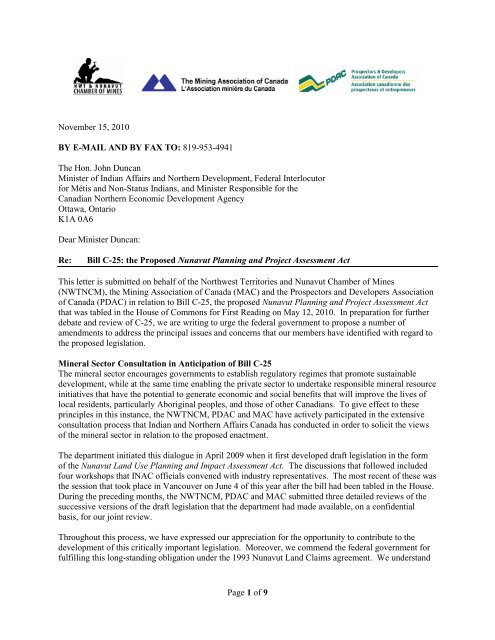

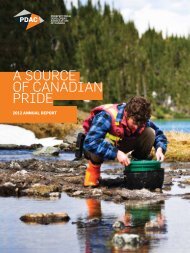
![Fredy Marino.ppt [Read-Only]](https://img.yumpu.com/46988510/1/190x146/fredy-marinoppt-read-only.jpg?quality=85)
